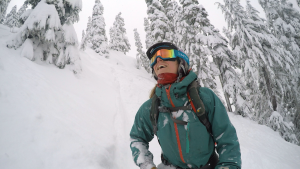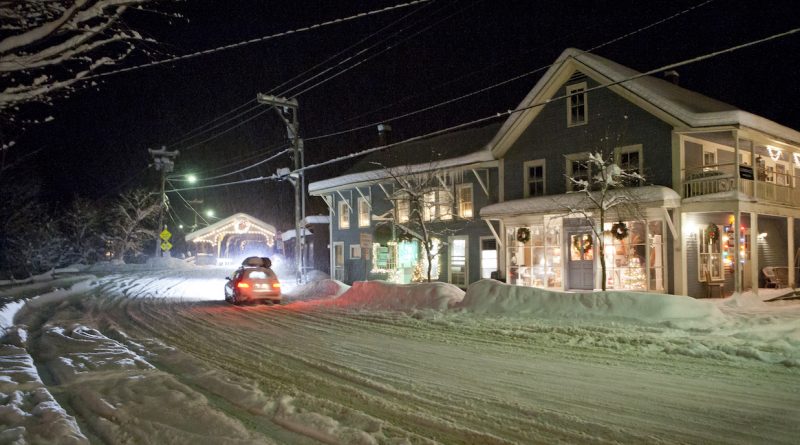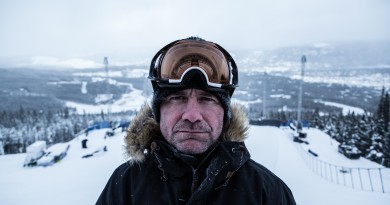Living (Or Leaving) The Dream?
Sugarbush’s creative Tenants for Turns program looks to solve a problem that’s plaguing ski towns around Vermont: where’s a poor ski bum to live?
From the outside, at least, Kristine Keeney, 29, is living the dream. Keeney, a community planner, moved to Waitsfield from Maine in June, 2016. Since then, she has tried to ski more than 100 days year. She skins, her job is flexible. She lives in the village of Waitsfield and can walk to the half-dozen shops and restaurants.
She has, in short, what every ski bum wants. And what ski bums —and anyone who is single and trying to make a living in a ski town—are finding increasingly hard to find.

According to a 2017 study by the Mad River Valley Planning District, the Valley will need to accommodate 459 more households to meet a projected population increase of 14 to 19 percent in the next decade.
And with rents and home prices going up, short-term rentals being increasingly offered via AirBnB and other sites, the chances of finding a place to bunk down are getting slimmer.
Already, the lack of housing is causing an outflux of young people —the types who might wait tables or load a lift at a ski resort. In fact, between 2000 and 2014, there was a 55 percent decrease in people under 35 in the Valley.
As one respondent to the organization’s survey put it: “After over a decade of renting in the Mad River Valley, I have concluded that is virtually impossible to find healthy, affordable, quality housing for someone with my income. I have considered leaving many, many times, but it breaks my heart to think of moving away from this amazing community so I intend to work hard, live simply and scrape by for as long as I can. Being able to own here seems more and more impossible as the years go by. The sad reality is, one day in the near future, I may have to leave.”
Aware of all this, Keeney set out to try to find solutions. “I’d heard of this Tenants for Turns Program out West and thought, hey, why not try it here.” The program, which has been used in such ski towns as Stevens Pass and Mt. Hood, Washington and during the summer, in Jackson Hole, Wyo., rewards landlords who make new housing available to ski area employees, with lift tickets or other perks.
Keeney wrote up a proposal and took it to Sugarbush. “They were really positive about it,” she says. The resort launched the program this fall. Landlords have to fill out an application and qualify (a relatively easy process). Their space is posted to a website and, when a tenant signs up, the landlord has the option of receiving 10 all-mountain lift ticket vouchers, a season pass to the Sugarbush Health and Recreation Club (SHaRC), or paying $100 for a full season pass.
Hilary Grey was one of the first people to sign up for the program. Unbeknownst to Keeney, her landlord had signed up and Grey, in her early 20s, will now be one of Keeney’s roommates. “It’s going to work out just fine.” Keeney said.
While this is one innovative program it will take more to solve the housing shortage that plagues ski towns. In early October, Rob Katz, the CEO of Vail Resorts, and his wife Elana Amsterdam pledged to donate approximately $58 million from the sale of his company stock shares to a fund that will help the mountain towns where Vail Resorts operates. The fund will allocate grants to non-profits. “We hope the grants can help make a difference by bringing people and programs together around community problems that need solutions,” Katz said.
Already, towns like Stowe, Waitsfield and Woodstock are looking at other ways of opening up housing stock. In Woodstock, people are encouraged to rent their homes during peak foliage season in the fall but after that need to apply for a conditional use permit if they plan to rent for 30 days or longer. Stowe will soon be requiring landlords to register their short term rentals, meet fire codes and pay the rooms and meals taxes, says town planner Tom Jackman.
The growth of AirBnB has been felt primarily in Vermont’s ski towns, which make up seven of the 10 most popular towns for 2017. According to AirDNA, Killington and Stowe lead the list with 486 and 482 listings repeatedly, with Ludlow, Warren, West Dover, Jeffersonville and Wilmington rounding it out. In Warren, the occupancy rate was 21 percent with an average daily rate of $218 .
Of course, those arriving at the short term rentals bring revenue to the towns and the ski resorts: Vermont AirBnB hosts took in $17 million in 2016 alone, with Stowe alone bringing in $2,131,757.
However for ski resorts, the challenge of finding workers is real. Vermont, like many other ski states, often relies on importing seasonal workers for six months from other countries under the H-2B visa program. Nearly 10 to 15 percent of Vermont’s ski resort employees now are here under the visa program and if Congress allows that federal law to change, resorts are going to be looking even harder for employees like Hilary Grey.





Good program, let’s hope other ski areas adopt it. Where do all the imported workers live?